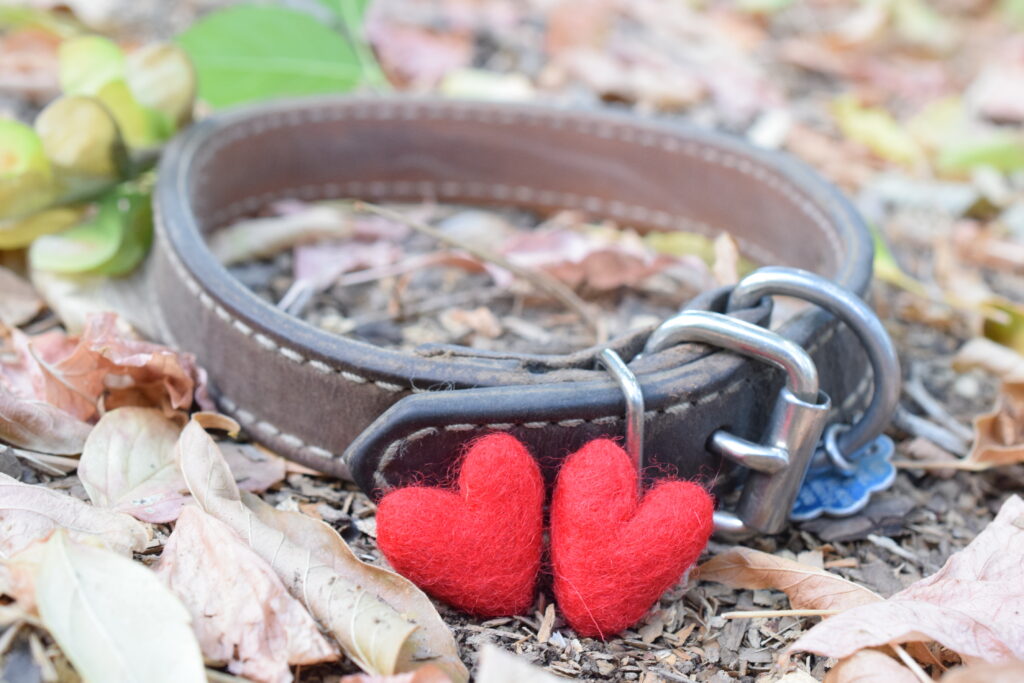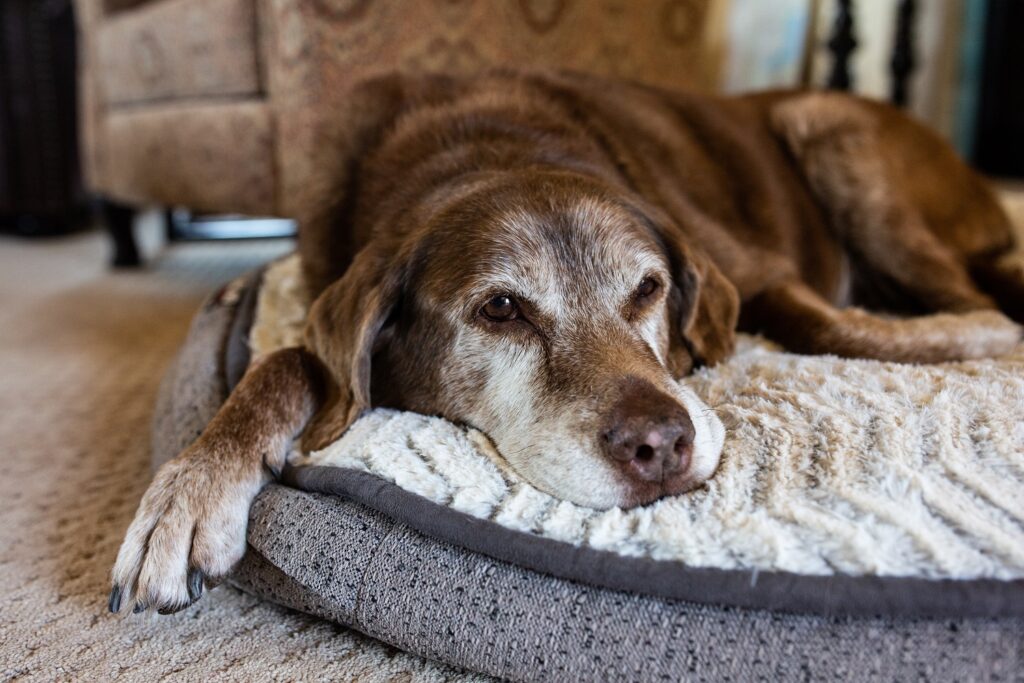by Jillian LaCross
When a dog enters your life, he or she shares your life. It doesn’t matter if you got your dog as a puppy from a breeder or as an older dog from a rescue organization. The moment those four legs cross your threshold is the moment when life will never be the same – and you will share hundreds of thousands of moments together.
Until that fateful moment when your beloved friend is gone.
The sense of loss is palpable for many dog owners. The emotions felt toward the dog while he was alive – happiness, elation, peace, pride, and yes, even irritation – can be replaced by a myriad of unpleasant emotions that boil down to a single experience when he crosses the Rainbow Bridge: grief. Yes, most of us know what it’s like to grieve the loss of a dog, and if you’ve owned dogs for decades, you also know that the loss of some dogs, or one dog, is tougher to accept than others.
Why loss is difficult.
“I can’t tell you how many people have said to me, ‘I don’t understand this,’” says Colleen Rolland, certified Pet Loss Grief Recovery Specialist and President of the Association for Pet Loss and Bereavement, who resides in Ontario, Canada. “And they always say it in the same tone. It’s almost like they’re ashamed of it. They’re mystified as to why they are feeling such strong, tumultuous emotions.”
A sense of loss can be profound because of the deep bond a dog and a human being share. For Rolland, inviting a struggling individual into a state of context is a good starting point to begin understanding these emotions. “I usually start sessions by talking about the animal-human bond and why it is so strong, so they have some context within which to view their grief. I talk about the caretaking loop, which I think is especially important because normally a caretaking loop gets established very quickly. You look after all of the needs and wants of the dog – the social, the physical, the emotional, etc. In return, the dog looks after you by providing unconditional love. That bond only strengthens and grows over time.”
It also depends on the role that the animal has in a person’s life. What made that dog so special? Rolland explains the reasons vary widely. It’s a question that is unique to each grieving individual. “It could be that they are the animal companion of a young couple who don’t have children and which represents their surrogate child,” says Rolland. “Or, it could be a twelve-year-old only child who grew up with that animal and represents a surrogate brother or sister. With an elderly couple, it could be the last link to a spouse who has recently died. It could be a police officer whose working dog is shot in the line of duty.”
Each relationship is special in its own way, just as relationships with individual people are inherently unique. Loss is difficult because of the great love and the great bond that used to be experienced on a daily basis with the loving presence of a four-legged friend. With death, we not only lose a dog we love, we lose our rhythm and sense of peace. We will never be the same.
The stages of bereavement for pet loss.
People experiencing pet loss may feel misunderstood, including by others around them, sometimes, the closest people in their circle. The comments may be made from a good place (“I know you miss your dog, but it’s time to move on, you can always get another one”), with the intention of trying to help the person who is struggling. However, if you know anything about grief, it’s that it doesn’t have a start or end date. It’s not a switch that can be turned on or off at a whim. The smallest things can trigger memories or emotions.
Oftentimes, grieving begins before the companion animal’s death. Coleen Ellis of the International Association for Animal Hospice and Palliative Care identifies this as anticipatory grief. “It’s wondering what life will be like after the dog is gone, if you’ll be able to recognize when it’s time. People also need to understand that there is a window of time, it’s not finite, and every window is a different size: There is a window of time when it’s the ‘right’ time to let a dog go.”
Getting through a loss takes time. “There are people who just don’t get the significance and the depth of the animal-human bond, and sometimes it’s through no fault of their own,” explains Rolland. “It’s just they don’t understand it, and grieving pet parents will run into them. And what happens then is that they bury their grief instead of processing it. They push it down inside, and eventually, it comes out in different ways.”
Ellis agrees. “Emotionally, you’re reacting versus responding. Think of a soda bottle being shaken up with the cap on. If you release it all at once, you know what’s going to happen. What we need to do is release a little bit at a time.”
Grief has identifiable stages when it comes to losing a precious pet. The stages are (1) shock, disbelief, and denial; (2) anger, alienation, and distancing; (3) guilt; (4) depression; and (5) resolution. “By talking about the stages of bereavement for pet loss, it gives individuals a road map of what they can expect to experience throughout the time of their bereavement,” explains Rolland. This is helpful because it validates what they’re feeling and experiencing.
Does each stage of bereavement have a determined start and end? Do you proceed in order through the stages? “The first stage is always the first, and the last stage is always the last,” says Rolland. “The first stage doesn’t last very long. You can bounce back and forth between stages two, three, and four like a ping pong ball, which can be really hard. You think you’re just getting through it and then all of a sudden something will trigger a memory or somebody will say something and it just ricochets you back to, maybe, the anger state. You bounce around until you process the grief, understand it, and you reach the stage of resolution.”
To travel through the stages of bereavement is unique for each individual. Some people do well learning on their own. They can read articles, process the information, accept the information, apply it to their situation, and be on their way toward resolution. There are others who “need a bit more of a hand,” according to Rolland. That’s where resources come in handy (see sidebar). There is support and help available. “It depends on the person as to what type of help is going to work best for them,” says Rolland.
Specifics surrounding the loss are important.
There are several ways by which to lose a beloved pet, and the circumstances of the death have an impact on your emotions as you navigate the stages of bereavement in its wake, particularly guilt (stage three).
“Every pet parent goes through the guilt phase,” says Rolland. “How long it lasts will depend upon the circumstances of the death. There are two types of guilt: one is called merited, and the other is called unmerited.
“Merited guilt is when somebody, for example, takes a dog out on a really hot day and decides to stop and pick up some milk,” continues Rolland. “In the grocery store, they meet somebody they haven’t seen for a long time and are in the store longer than they anticipated. They return to the car and the dog has died from heat stroke. It’s an awful situation that brings with it merited guilt; it is very difficult to work through, and it has to be addressed. A certified pet loss grief specialist can help reframe it that it was an accident. Yes, that person should not have done it; however, people are human. They make mistakes. And there has to be self-forgiveness. Working through that is difficult.”
Unmerited guilt comes when death occurs even if an owner does everything “right.” For example, they never miss their annual checkups or immunizations, they feed the best food, they ensure their pet is taken care of in every aspect, yet the animal gets sick with a disease and hides it for some time, until it reaches dire circumstances and euthanasia is the only solution. These are individuals who are generally attuned to their pet, feel like they missed something, that they were negligent, when in fact, that’s far from the truth. “They did nothing wrong,” explains Rolland.
The association Ellis works for focuses on palliative education and care, so there are often things that can be done to enhance the quality of life of the animal in late stages, such as incorporating pain medications, utilizing warm blankets, and making tweaks to existing medication so that more time can be spent together and you can better prepare for the inevitable event.

“There are things you can do to help make your pet more comfortable. Don’t be afraid to ask for a higher or different level of care for your dog,” says Ellis. For individuals who have been trained by the International Association for Animal Hospice and Palliative Care, the approach to palliative care for your dog is similar to that for humans. “In our walk with someone, it could be you’re texting a few times a day to make sure you’re doing what you should be doing to make the dog comfortable. It’s an extra level of support and understanding,” describes Ellis.
An individual may recognize that their dog is ready, but he or she may not be. To prepare, soak in the last bit of time with your beloved pet: go to that favorite spot the two of you shared together, give a favorite treat, spend time cuddling. Ellis recommends taking the time, if there is time, for the death event by doing these sorts of activities, and to think about what you desire the end to be so that you can unequivocally say, “It was a perfect end.” The support of family, friends, and veterinary professionals is also essential to make this desire a reality.
However, sometimes we don’t get to choose and create the circumstances for that perfect end, which need to be reconciled during the grieving process. Regardless of the circumstances, you can spend the time mourning afterward in ways that make you feel as though you are honoring your friend, a companion animal who means so much to you, in the right way.
Other pets in the home.
The International Association for Animal Hospice and Palliative Care acknowledges that surviving pets in the home can also go through a grieving process and that “the closer the bond that pets share, the deeper the grief.” Changes to a surviving dog’s habits are the tell-tale signs that he might be struggling. And these changes can lead owners to be concerned about the physical health and longevity of the animal, worrying that they might lose another beloved friend. However, the actions are simply the dog’s way of dealing with the loss and are typically short-lived. Some examples of a dog who is struggling with the loss of a canine housemate are lying around a lot more, moodiness, loss of interest in favorite activities, overgrooming, pacing, and even digestive upsets.
“I’ve had many people tell me that their surviving dog runs to the door every time a car drives by,” says Ellis. “They are anticipating seeing their friend. To take the dog to the vet, load him up in the car, and he never comes back is confusing. If possible, bring the deceased dog back home for a day or two to prepare yourself and everyone else for the separation from the physical body. Let the surviving dog smell the deceased, that his friend is no longer there. If that’s not possible, then cut off some hair and bring it to the surviving dog at home to smell.”
As for moving stuff out, “Don’t do anything in a hurry,” suggest Ellis. “If it brings comfort to your dog at home to lay on the bed of the deceased dog, let him do it. Likewise, if you have an old toy or piece of clothing that smells like the deceased dog. Let your surviving dog have those things.”
The “replacement theory” of adding a new dog quickly to try to help salve the pain of loss, which both Ellis and Rolland caution against, also applies to other pets in the home, especially those who were close with the deceased dog. Back in 2008, authors Karen Edwards and Margaurite Marsh wrote an article for Just Labs titled “When Your Pet Grieves.” Within that article, they astutely write: “Before bringing in another dog, see how your surviving dog responds to other animals. When he or she starts to show interest in other dogs, you can feel comfortable adding another pet to the house.”
Of course, you need to be ready, too, and already having another companion animal at home going through the loss is good for the soul…for both of you. Remember being reactive versus responsive? Keep that in mind with surviving animal housemates. They still deserve to be treated well, even if you’re hurting.
Working toward healing.
“The person who taught me about pet loss, Dr. Wallace Sife, always said that the saying ‘time heals all wounds’ is really a misnomer,” explains Rolland. “Time just polishes off the sharp and jagged edges. Pain will dull over time so that you can move on and open your heart to another animal.”
Ellis agrees. “If people are not given the support to grieve and then get another dog, then they may not connect well with the dog, or feel like they can’t love like they know they can because they haven’t done their mourning work.”
Mourning work activities should take place following a dog’s death. “Mourning work might be scrolling through pictures on your phone. It might be going on a walk with your deceased dog’s collar and leash in your pocket. It might be sitting outside in the morning with a cup of coffee in a moment of self-reflection. Whatever is best for you, do it,” says Ellis. Taking the time to do this will help you open your heart and mind to potentially adding another animal.
Is getting another animal the solution for some people? Or if you’re getting one too soon, is that just a Band-Aid, because you haven’t processed the grief properly yet? This is a common dilemma.
“What I can say to that,” explains Rolland, “is that I have had clients who have done that – they’ve got the one animal who has died, and within a few days or a couple weeks, they have not processed their grief, they go out and get another animal. Then they are really upset because that animal is not the other one, so they’re going through all sorts of growing pains with them. They get angry, they get resentful. It was a decision that wasn’t made properly.”
“When we grieve, we get foggy,” observes Ellis. “We might make decisions that aren’t completely thought through. Give yourself time. Put the deceased dog’s toys and other items away in the garage if you need to. Don’t do anything irreversible. After the fog has cleared, you might want to hold onto something. Or, you might want to donate everything. Both are okay. Just take the time.”
Processing the grief of your dog’s loss is important to do before going to look at another dog. How long does that take? “It’s all individual. They’re all different. You need to take a really good, hard look at where you are in the process,” explains Rolland, noting that even if you do go look at another animal, know ahead of time that no two animals are going to be alike. “I think animal people have such a huge capacity for love that they shouldn’t limit themselves to one love,” says Rolland.
However, some dogs are more difficult to “get over.” Specifically, your heart dog, the dog who is unlike any other dog. The dog of a lifetime. The grieving process for a heart dog can be especially difficult. Ellis spoke about a dog she lost 20 years ago, and she still sheds a tear.
It’s part of the deal we make when we bring that dog home in the first place. We know death is going to happen, though we don’t know the circumstances. Even if you have time to prepare, letting go still isn’t easy.
Understanding that losing a companion animal can greatly affect human mental health, which can therefore affect our physical well-being, it’s important to take care of yourself emotionally and physically. The International Association for Animal Hospice and Palliative Care has downloadable PDFs with suggestions of how to care for yourself following the death of a beloved animal. Doing so will help you work toward healing and resolution.
For instance, emotionally, find friends who are sympathetic to talk to, to share how you’re feeling. Engage in creative outlets, allow yourself some leisure time, interact with the people around you and try to avoid isolation. Yet, find time to be alone, either at home or in nature. Physically, go for walks, eat healthy foods, take a break from sweets or caffeine. All in all, listen to what your body and mind need.
Ellis adds that the first year can be especially difficult. “There’s a year of firsts following a death. There’s the first birthday, the first Christmas, the first season without the dog around. There will be a few times when reality is going to smack you in the face. It’s usually unexpected. Knowing that, will you give yourself permission to feel those emotions when they come? How will you respond when you see your dog’s stocking? Or when he’s not there to jump into the car to go somewhere?
“Grief doesn’t go away, grief is something we get through. We need to give ourselves permission to feel.”

Move forward in hope.
Many dog owners, after experiencing a loss, find consolation by honoring their faithful companions. A personalized garden rock, a photo in a special frame, and adding the dog tag to your key ring are all examples of ways to honor and remember your four-legged friend.
Dog owners have a tremendous capacity for compassion and love. Having these abilities also usually means there tends to be a tremendous sense of loss after a pet dies. However, there is help available if needed, and grief can be navigated in healthy ways. “Love and grief are equal. We grieve so much because we love. It was real,” says Ellis.
“It doesn’t have to be a long, drawn-out process,” adds Rolland, “if you can explain that the love they shared is never going to die and that their animal companion is always going to be a part of them.”
Resources
It may seem like nobody understands, or you feel stuck somewhere within the grieving process and can’t manage to see the way out. Perhaps you want to be able to find the words that seem difficult to comprehend. There are organizations with resources readily available to individuals navigating through the loss of a companion animal, whether it’s during palliative care or after death.
www.aplb.org: At the Association for Pet Loss and Bereavement, you can become a free Bronze Member. Once you sign up, you have access to the online chatroom, where a lot of other people experiencing loss find counsel and understanding. There’s a directory of services, too, as well as a comprehensive news section with educational articles written by staff members. There is a lot of support available online through this organization dedicated to pet parents.
iaahpc.org: The members of this association are primarily veterinarians, and the remaining 15 percent of members are certified animal advocates. However, there is a lot of important information on the Pet Parent page on the website. There are four downloadable PDFs on grief specific to owners who have lost a beloved pet. This is the area Ellis points to as having the most resources. The Quality of Life scale is available everywhere, but that’s a great resource, too, according to Ellis. This scale can easily be utilized by a family on an everyday basis when the dog is in his or her last days to better identify when it’s time to let go. And of course, veterinary professionals and tech professionals, especially those formally trained by the organization (a list of providers can be viewed on the website via “Find Support”), are wonderful resources for owners before and after the loss of a pet.
A pet loss grief specialist will see a person for one or two, maybe three, sessions. After that, if somebody still needs help, for example, for serious depression or inability to cope, they will refer a person to a mental health counselor (psychotherapist, psychologist, social worker), preferably one who understands the important bond animals and people share.




